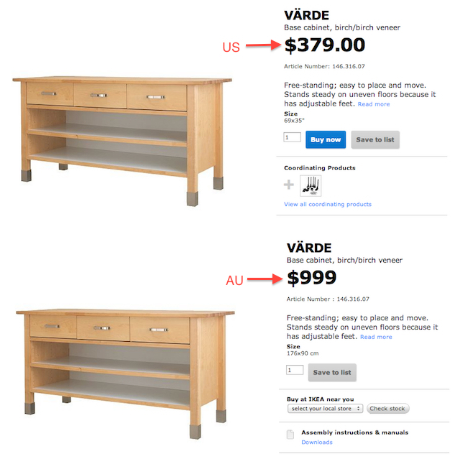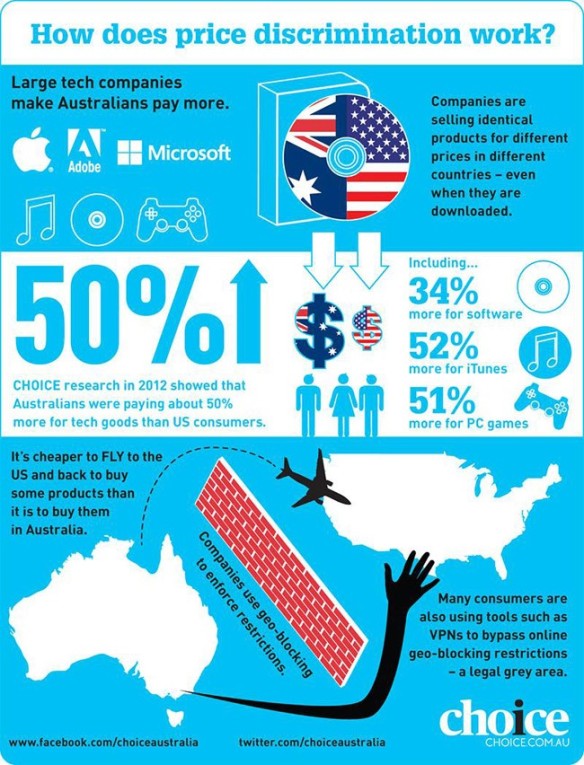By Victoria Palmer and Edward Howard
Pricing. An issue that never ceases to amaze. In store or online, domestic or overseas, the possibilities are endless and more recently so are the differences. It is becoming exceedingly apparent that there has been an emphasis on the price discrepancies between products available in Australia and the price of these same products in overseas markets.
What happens to public perception when a product is priced at an inequitable rate? Is it reasonable that someone in Australia pay the same for the exact same item as someone in the United States?
Obviously, there are factors that must come into play when approaching pricing, including cost of development, sales infrastructure, national/state regulation and cost of shipping the item to another location. But, what if those elements are almost nil in the case of digitally delivered products?
This is a real issue, especially in the IT sector. For instance, the price differences between the cost of computer games on Steam (an online game provider) in the Australia compared to the cost of the same computer games in the US offered by the same platform. There is no delivery, no packaging, just a ‘click here to download’.
Many major corporations, in terms of the digital and physical consumer business have been under attack for inflating prices in markets like Australia. The following article highlights this:
http://www.abc.net.au/news/2013-03-22/apple-microsoft-grilled-over-high-prices/4587900
Unfortunately, this disparity is not only limited to computer related products. Homeware and furniture giant IKEA was also in hot water in recent times, due the inflation of the price of its products in Australia compare with the exact same product in the US. As shown below:
Even with the conversion rate: That’s over $500 difference for the same product! And it’s not only Australia, similar cases have been reported in the UK.
That’s over $500 difference for the same product! And it’s not only Australia, similar cases have been reported in the UK.
Pricing is one of the key factors a company must consider when entering a product into the market. It is the mechanism that guides customer choice and satisfaction and reception of the product. Appropriate pricing also influences profitability. Pricing is also another way in which a corporation can position its product or direct it towards a specific market segment. How the product is to be perceived has great impact on its success or failure.
The Australian government has supported this ideology and has attempted to hold many of these corporations accountable for pricing decisions. Taxation and cost of doing business is also a major factor, but does it mitigate the pressure to price more equitably?
The key difficulties are in the ‘trade-off’ that customers are willing to make when considering the utilisation of a particular product. Is it worth the price? Does it offer value? Is it competitive? Are there other similar products available?
The second, relating to customer psychology, does this pricing structure and discrimination adversely effect a companies brand and its ability to generate revenue in the market. In this instance it could be argued that in the case of digital media, consumers were turning to pirated media sites, not benefiting either the companies or the artists themselves. After media reports of the price differences across the IKEA brand, the company publicly back peddled its pricing stance, by reducing the price of selected items across its Australian stores. This also potentially impacts on sales revenue, profitability and consumer faith in the brand. Is a pricing structure that drives consumers to illegal activity or forces a public rethink of prices, the right approach?
Conversely, consumers are driving pricing strategies for companies like Apple, who have inelastic demand for products. Despite the price differences Apple continues to build a greater brand presence. But, has it hurt them in terms of their digital presence, with the introduction of cheaper services like Spotify and Netflix. Will companies like Netflix and Spotify have to be mindful of pricing out their markets? We have seen some price reduction in some of Apple’s products given the recent weakening of the Australian dollar. Is the market responsive, perhaps to a level? But is it just? Should a brand capitalise and take advantage of its consumers’ and their desire for its products?
I’m not entirely convinced this is fair. But, maybe fair has nothing to do with it.
Sources:
http://www.abc.net.au/news/2013-03-22/apple-microsoft-grilled-over-high-prices/4587900
http://www.theaustralian.com.au/life/personal-technology/australians-pay-50-per-cent-more-for-tech-goods/story-e6frgazf-1226687429151
https://hbr.org/2011/07/why-im-not-going-near-spotifyhttp://www.smh.com.au/digital-life/smartphone-apps/apple-australia-slashes-app-prices-by-up-to-25-20110714-1heuu.html


Maybe thats why australia is the most expensive country to live in the world for the forth consecutive time
LikeLike
Fourth*
LikeLike
Really interesting post Victoria & Edward, & a real bug bear for most Australians who by stuff made overseas. No one has an issue with paying more to cover extra shipping costs, exchange rates & enough for the manufacturer & supplier to make a profit, anything else is a rip off. It certainly effects wether or not I buy something, usually means I wait ’til it’s on sale or they have a free shipping offer, or check out a competitor. My son just recently bought an item from Germany & paid the exchange rate, bank fee for international exchange, a shipping fee & a tax for being outside of Germany & making the purchase. Is it just me or is Australia behind the eight ball in dealing with some of these online shopping issues?
LikeLike
I think you’re right, I think Australia really hasn’t kept up with online shopping or become competitive with it. I do believe, as possibly odd as it may sound, that previously when the Australian dollar was weaker, the conversion rate was more on par for most products, but this has become out of sync with the strengthening of the dollar in more recent years, which is having an impact on online shopping especially.
LikeLike
As an Australian consumer this phenomena really sux ! Is it fair – no, is it unjust I am not sure. I feel the Geo blocking of downloads and similar is wrong and probably should be illegal as it restricts global competition. From a sellers perspective could this simply be justified as a form of global segmentation?. I also think it interesting that whilst some companies have been highly criticized for these behaviours it doesn’t seem to have had a long term impact on their brand. Does this mean that customers rarely look outside of their segment or in this case their region to compare prices. Do consumers only compare price seems reasonable compared to other retailers or similar products that are equal in terms of how they can be purchased. I know I don’t look overseas for purchase options even when I know I may be able to purchase them cheaper if I looked. It seems we have a way to go before the truly global nature of the internet extends to online shopping.
LikeLike
For the last 6-7 years I have shopped online for most of my clothes, books, DVDs and more increasingly electronic goods. The inflated prices in Australia cannot be attributed to firms covering cost, price sensitivity, or red tape. In my opinion it is a simple case of greed. Given that óptimal pricing’is attained when customers feel that they have received value back from the price they’ve paid, i believe as long as more people like me continue to do what i do, it will force retailers to adjust their price accordingly. Agree?
(keep in mind I’m happy to pay a little more than the US for example, to take into account the value of the $A. Its the IKEA example that frustrates me)
LikeLiked by 1 person
This is a great blog! Yes, the price differential is amazing, that’s why my suitcase is always much heavier on the way back from the US.
In the period 2001-2003, it may have been justifiable why Australians paid double the price compared to the US. At the start of 2011, when the Australian and US were at parity, I guess companies may think Australian consumers are non-questioning and accepting of this situation. I’d like to think companies would treat Australian consumers more fairly.
To be fair, suppliers of imported equipment typically quote in their local currency, so Australian companies are treated fairly, it’s seems to be consumers that are impacted.
LikeLike
Controversially, perhaps this phenomenon is simply reflective of the Australian consumer’s capacity to pay. Whilst we may be one of the most expensive countries to live in, we also rank about as high in respect to average household income and have a comparatively low unemployment rate.
Afterall price regulates the supply and demand of a product- if the price is too high the quantity supplied will exceed the quantity demanded and, conversely, if the price is too low the quantity demanded will exceed the quantity supplied. Therefore, in the case of IKEA one could conclude that sufficient demand exists for their pricey cabinet otherwise if demand was lacking you would expect to see the price reduced in order to regain market equilibrium in respect to supply and demand.
LikeLike
The opportunity for an organisation to get value back from the customer is via pricing. It is also fraught with traps for the modern retailer as tech savvy buyers are able to shop around globally with completely transparent pricing. The way in which a company like IKEA pitches its products in Australia to be low cost is clearly hypocritical with the example you have shown. On the other hand iTunes doesn’t sell itself as a low cost operator, and probably never will. It is their goal to make music, movies etc available. I believe here that the organisational pricing policy needs to be consistent with the image they have built over time.
LikeLike
I am glad you posted this because it is a topic I am forever complaining about. Having lived in the UK for 6 years, I know how much cheaper things can be. For example a flight from London to Melbourne return is equivalent to about $1400 Australian dollars, yet we can’t go Melbourne to London return for under $2000. They are the same planes, same companies, same pilots, you get my drift! People in the UK, however, tend to be better at complaining about price injustices. For example, there was such a public outcry when they started charging withdrawal fees if you withdrew money at an ATM which was not your own banks ATM (as they do here) that the practice was stopped in the UK. Us Aussies just put up with it!
The only factors I can think of that are reasonable are:
1. Australia has a very small population so companies won’t sell as much here. Does that drive prices up?
2. According to an American friend, salaries and wages in the US are significantly less than those in Australia. If they charged the prices there they do here, perhaps people simply couldn’t afford them?
A great blog, thanks!
LikeLike